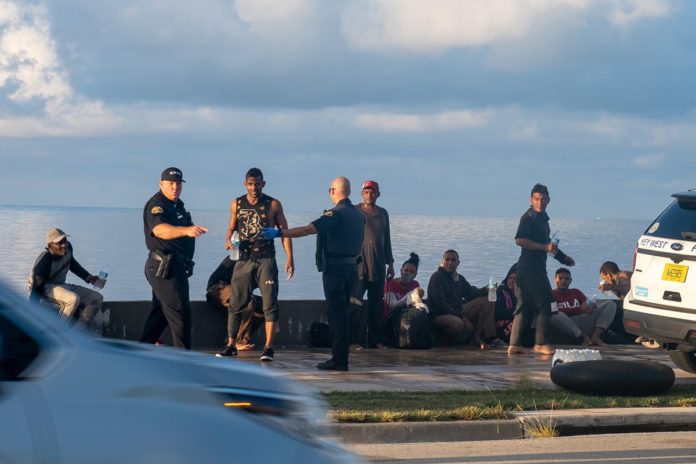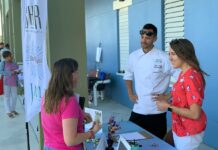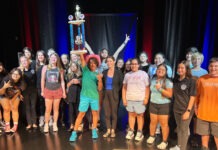There was a small flock of red-winged blackbirds up in the casuarinas over by East Martello. They looked to be all female, but they kept moving around. I couldn’t get an exact count.
There were also a good number of warblers. If I’d had my binoculars I might have been able to identify them down to species, but I hadn’t thought to bring them when I left the house. Migration was still going on, so it was hard to say if these were birds that were going to overwinter in the Keys, or if they were just taking a small break before heading to Cuba.
Down below the casuarinas, a handful of police officers were watching over two picnic tables full of people who had just come from Cuba, though “just come from” might not be accurate – they’d spent four days on a homemade chug crossing the Florida Straits.
My wife is a radio reporter, and Warren Leamard had called her about a half-hour earlier to tell her about the landing. Then he sent a video.
Leamard is a caterer, one of Key West’s great people, someone you’re always happy to see in a crowd, particularly when there’s a tray of his unbelievably flaky Jamaican beef patties around. I’m not sure why he was up and out at the beach that early.
The video, which a good number of people have seen online by now, showed one of those achingly beautiful Keys sunrises – the soft filtered light, the distant row of pastel clouds, the still water. And then, stretching out from the shape of a very small boat on the horizon, a line of figures moved toward the shore, some carrying packs on their heads, some tripping on the bay bottom, at least one person pushing an inner tube.
The Key West Police Department was there, and the Monroe County Sheriff’s Office, their cruisers, lights rolling, parked on the bike path.
When the figures got close to the sea wall, people, officers included, began reaching down. Hands grabbed hands. The Cubans were pulled out of the water one by one, drenched, exhausted, elated. They sat in a row on the cement curb.
Leamard was gone by the time we got there, but the scene was pretty much the same, if a little more crowded. More police had arrived, and joggers and cyclists, slightly mystified, regularly weaved their way among them and the Cubans. Everyone had bottles of water. Blue lights flashed. People drove by in cars and yelled encouragement in Spanish and English.
Everyone was even-tempered and kindly towards each other. The only yelling I heard was one of the officers, but that was because he wanted to make sure traffic was being stopped as they moved the Cubans in small groups from the seawall across four lanes to the picnic tables under the casuarinas.
One of the officers’ wives had brought them all breakfast (Cuban toast!) and the group seemed pretty happy, eating, joking, giving thumbs up, washing themselves with the bottles of water. There were 17 of them, 15 men and two women, one of whom was swinging her feet absently under the table.
All this was, of course, a fermata, a small pause before things went into motion again. These 17 people were mostly going to be repatriated to Cuba in the coming weeks, if not days.
I had mixed feelings when the Obama administration ended the wet foot/dry foot policy that allowed Cuban migrants who made it to shore to stay in the United States.
It had always seemed blatantly political and horrifically unfair that Cuban refugees were automatically allowed to stay, while undocumented refugees from other nearby countries, who faced equal, and often greater, dangers at home, were not. (See: Haiti.)
I did not think more restrictive immigration policies was the answer.
The only clear benefit was that ending wet foot/dry foot seemed to deter people from crowding onto frail, homemade boats and attempting to cross 90 miles of dangerous ocean. Until recently.
From October 2019 to October 2020 the Coast Guard stopped 49 Cuban refugees from entering the United States by boat. From October 2020 to October 2021 they stopped 838.
The boats they are building to get across are getting flimsier and flimsier. Most of what you used to see were at least modified rowboats and small fishing boats with gunnels raised with sheet metal and seams filled with foam. Several of the more recent chugs I’ve seen on beaches have been little more than metal frames stretched with PVC tarps. A few sparks off an improvised motor and…
You think about how many boats get found floating empty out in the Gulf Stream, about how many boats leave from Cuba, never to be heard from again.
You may question why I’m writing about all this in such a disorganized way in a column that is allegedly about wildlife. The short answer is, I fill this space most weeks by going out into the world and seeing what there is to be seen, and maybe contrast the non-human and the human. And last Sunday morning I saw this. And to not be moved by the sight of these people experiencing a little joy in the brief respite between making a hellacious journey to get here, and being sent back to the situation that inspired them to make such a journey, would be as hard-hearted as it gets. There is no one more human than those people sitting on those benches that morning.
Borders are intellectual constructs enforced with maps and guns. Cultural differences, nations? They don’t exist in the bird world. Or among all the other species on the planet, save ours.
As a species, we need to do better.


























